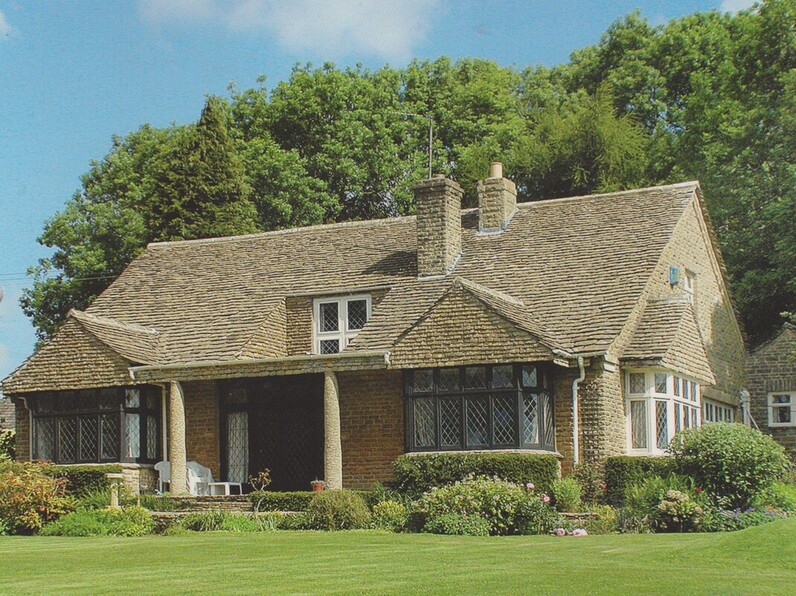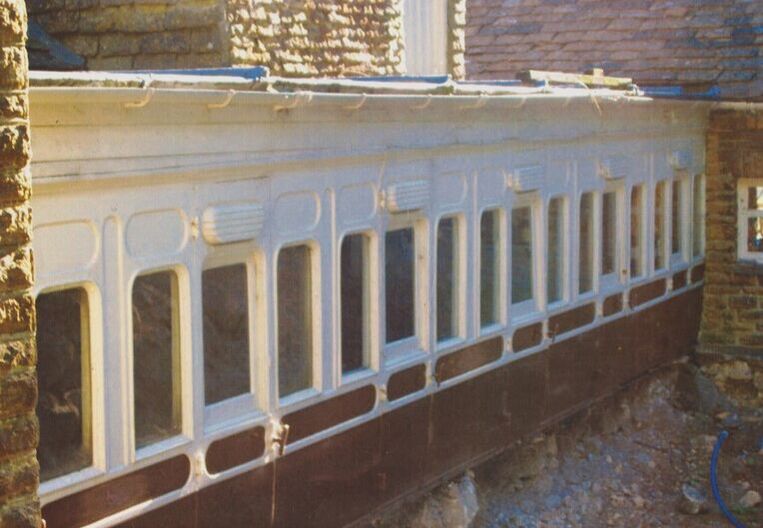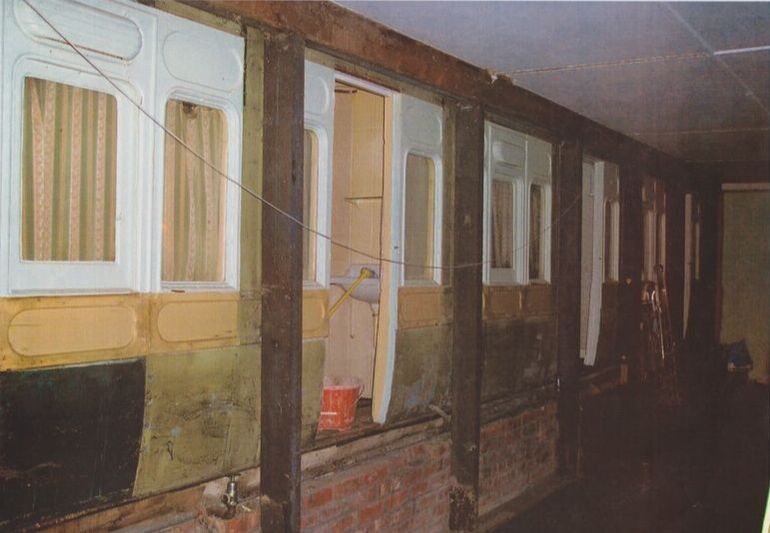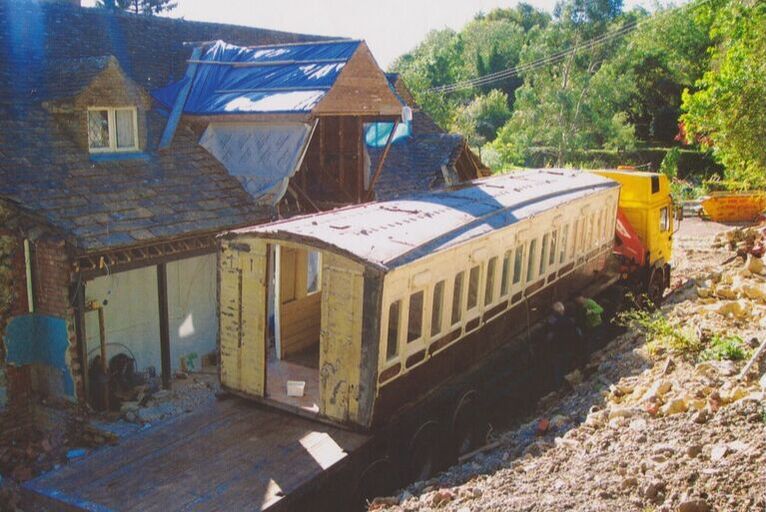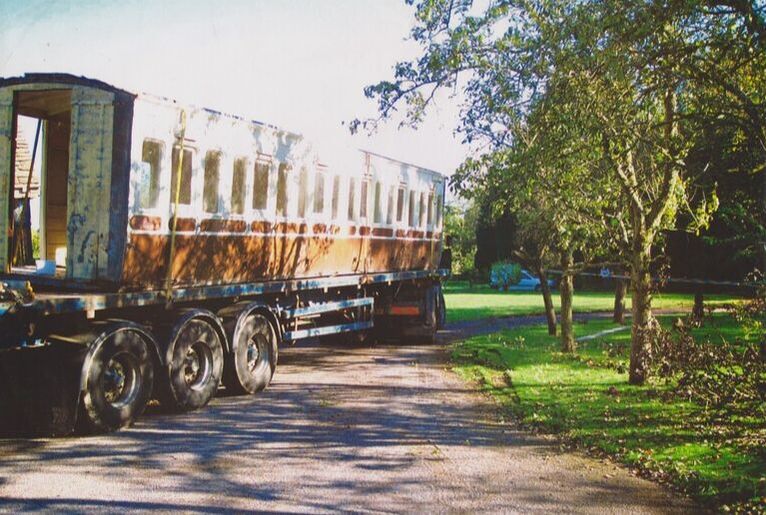Our Domestic Railway Carriage Text and photos Christine Smiddy, July 2021
I was most interested in your article about the railway carriage at The Retreat as we were owners of the house from 2003 to 2015. We bought the house with the railway carriage from the estate of Susan Catronnelli, who had lived there for about 30 years.
Early History of the House
The Sparrow family owned the land from the 1920s and they started by using the railway carriage as a mobile home on the land. It was a get-away from their house in Chapel Lane, Bath, and a separation from the legal firm that William Austen Sparrow ran from the Bath house. It was a retreat from the city of Bath to a rural idyll for the family after the First World War. The building of a property in the grounds came when the family submitted plans to Wiltshire Council in 1936-37, showing how the carriage was to be incorporated into the house and the landscaping of proposed gardens in the grounds.
When we bought the house in 2003, the carriage was still in existence. However, it was in a bad state of repair and the upstairs rooms had been rented out for some time to servicemen working for the Ministry of Defence and Royal Arthur and later as accommodation for Linguarama at Cheney Court. The agent’s sale particulars described the coach as: The carriage offers a bathroom and trio of three smaller rooms, all accessible from the drawing room. From the carriage, stairs lead up to the first floor with its principal bedroom suite and three further bedrooms.[1] As you turned a corner towards the carriage, it was like going out onto a railway platform.
Early History of the House
The Sparrow family owned the land from the 1920s and they started by using the railway carriage as a mobile home on the land. It was a get-away from their house in Chapel Lane, Bath, and a separation from the legal firm that William Austen Sparrow ran from the Bath house. It was a retreat from the city of Bath to a rural idyll for the family after the First World War. The building of a property in the grounds came when the family submitted plans to Wiltshire Council in 1936-37, showing how the carriage was to be incorporated into the house and the landscaping of proposed gardens in the grounds.
When we bought the house in 2003, the carriage was still in existence. However, it was in a bad state of repair and the upstairs rooms had been rented out for some time to servicemen working for the Ministry of Defence and Royal Arthur and later as accommodation for Linguarama at Cheney Court. The agent’s sale particulars described the coach as: The carriage offers a bathroom and trio of three smaller rooms, all accessible from the drawing room. From the carriage, stairs lead up to the first floor with its principal bedroom suite and three further bedrooms.[1] As you turned a corner towards the carriage, it was like going out onto a railway platform.
The Carriage
We have been told that it was a second- or third-class 1895 Pullman carriage from Barry, South Wales. Possibly it became redundant when the Great Western Railway took over the Barry Railway in 1922. I understand that the GWR was reluctant to adopt the luxurious Pullman carriages at first and presumably felt they had no need for a third-class carriage of this nature.
The carriage at The Retreat has become very well-known and I have come across many people who have had some link or tale to tell about its quirks. One of the tradesmen involved with our works had been to the house many years earlier when there were a series of life-size cut-out cardboard figures of Victorian people in the carriage. Approaching it from one side you had to climb four stairs which led to a drinks bar, then turned a corner and up through the roof of the carriage., returning into the house at first floor level in a covered corridor. We kept the bar cabinet for later use in the main house in a concealed cupboard in the library.
During our time we undertook major renovation works to the property. We felt it was such a shame to lose the carriage which still had leather straps on the windows and the mahogany frame was intact but the chassis and panels had deteriorated too much to restore in situ.
We have been told that it was a second- or third-class 1895 Pullman carriage from Barry, South Wales. Possibly it became redundant when the Great Western Railway took over the Barry Railway in 1922. I understand that the GWR was reluctant to adopt the luxurious Pullman carriages at first and presumably felt they had no need for a third-class carriage of this nature.
The carriage at The Retreat has become very well-known and I have come across many people who have had some link or tale to tell about its quirks. One of the tradesmen involved with our works had been to the house many years earlier when there were a series of life-size cut-out cardboard figures of Victorian people in the carriage. Approaching it from one side you had to climb four stairs which led to a drinks bar, then turned a corner and up through the roof of the carriage., returning into the house at first floor level in a covered corridor. We kept the bar cabinet for later use in the main house in a concealed cupboard in the library.
During our time we undertook major renovation works to the property. We felt it was such a shame to lose the carriage which still had leather straps on the windows and the mahogany frame was intact but the chassis and panels had deteriorated too much to restore in situ.
Saving the Carriage for Posterity
The carriage was still an integral part of the house and, to extract it, we had to knock down the bathroom, kitchen and a walkway which provided access through the carriage to the second floor of the house. We also had to excavate a large area to get a lorry into position to lift the carriage out intact. It had been decommissioned and the wheels and bogies removed. Part of the chassis was rusting away and it looked a rather sad picture when fully exposed.
The carriage was still an integral part of the house and, to extract it, we had to knock down the bathroom, kitchen and a walkway which provided access through the carriage to the second floor of the house. We also had to excavate a large area to get a lorry into position to lift the carriage out intact. It had been decommissioned and the wheels and bogies removed. Part of the chassis was rusting away and it looked a rather sad picture when fully exposed.
We realised that that there were only a handful of such carriages still in existence and we advertised it on a specialist site to railway enthusiasts. We eventually donated it to Roger Gell, an architect & railway restorer, who took it to a warehouse in Wales, hoping to get funding to preserve it. Removing it from site was a complicated and momentous occasion, with several locals turning up to watch. We had to cut down various trees to manoeuvre it out of position and onto the road.
Do you have any stories of this amazing railway carriage and its integration into the house? If so, Christine would love to hear your recollections. Or perhaps you know of present plans to restore it. Please let us know if you can add to its story.
Reference
[1] Sales Brochure, Cluttons and FDP-Savills, 2003
[1] Sales Brochure, Cluttons and FDP-Savills, 2003
